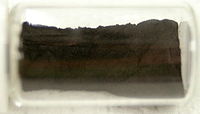
Photo from wikipedia
We show a hard superconducting gap in a Ge–Si nanowire Josephson transistor up to in-plane magnetic fields of 250 mT, an important step toward creating and detecting Majorana zero modes… Click to show full abstract
We show a hard superconducting gap in a Ge–Si nanowire Josephson transistor up to in-plane magnetic fields of 250 mT, an important step toward creating and detecting Majorana zero modes in this system. A hard gap requires a highly homogeneous tunneling heterointerface between the superconducting contacts and the semiconducting nanowire. This is realized by annealing devices at 180 °C during which aluminum interdiffuses and replaces the germanium in a section of the nanowire. Next to Al, we find a superconductor with lower critical temperature (TC = 0.9 K) and a higher critical field (BC = 0.9–1.2 T). We can therefore selectively switch either superconductor to the normal state by tuning the temperature and the magnetic field and observe that the additional superconductor induces a proximity supercurrent in the semiconducting part of the nanowire even when the Al is in the normal state. In another device where the diffusion of Al rendered the nanowire completely metallic, a superconductor with a much higher critical temperature (TC = 2.9 K) and critical field (BC = 3.4 T) is found. The small size of these diffusion-induced superconductors inside nanowires may be of special interest for applications requiring high magnetic fields in arbitrary direction.
Journal Title: Nano Letters
Year Published: 2019
Link to full text (if available)
Share on Social Media: Sign Up to like & get
recommendations!